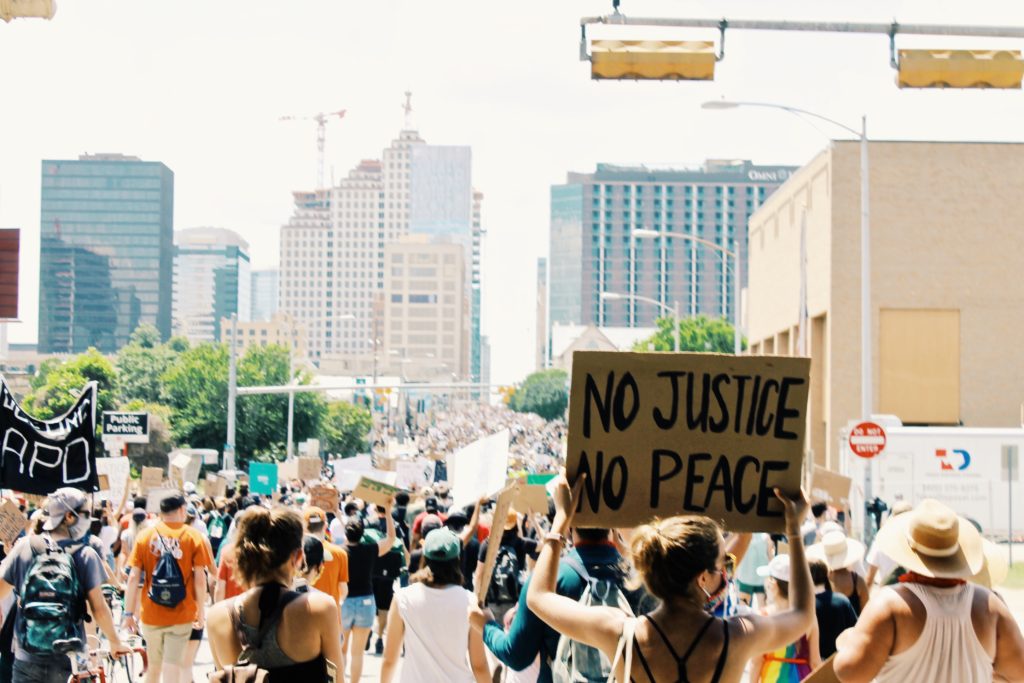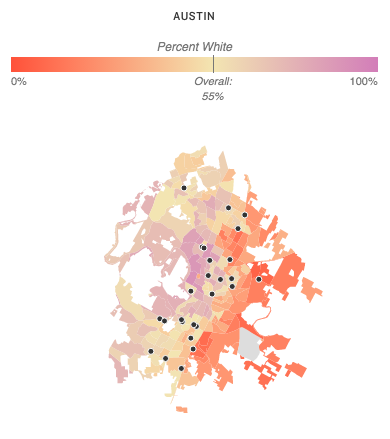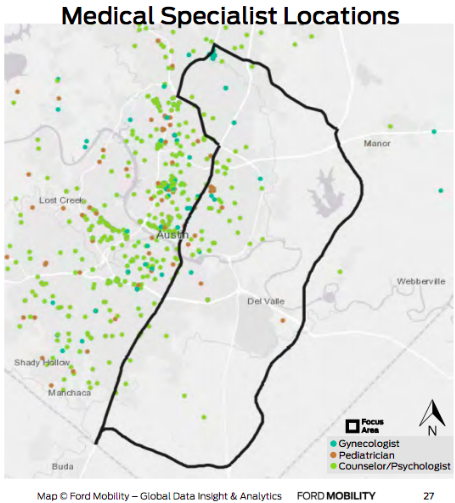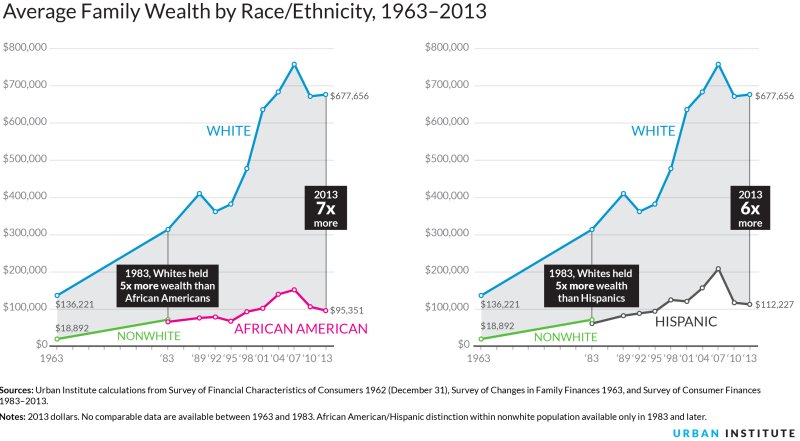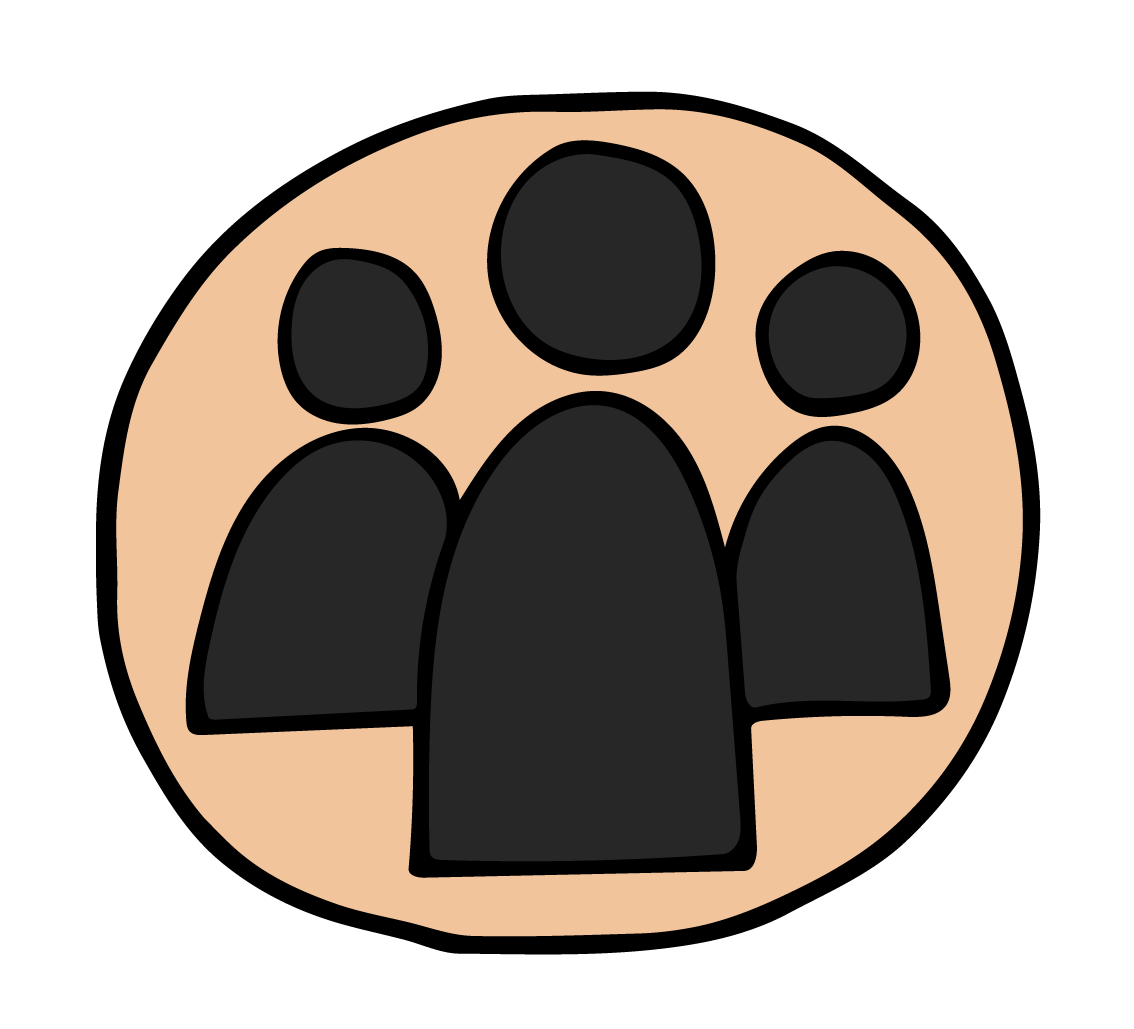
About The Author
Janis Bookout is the Executive Director of Earth Day Austin, as well as one of the organizers of Community Resilience Trust, a grassroots coalition that came together in response to the COVID-19 pandemic, with the goal of making Austin a more equitable city for everyone. Janis regularly contributes guest editorials & posts to The Austin Common. You can support her work by contributing to her Patreon account.
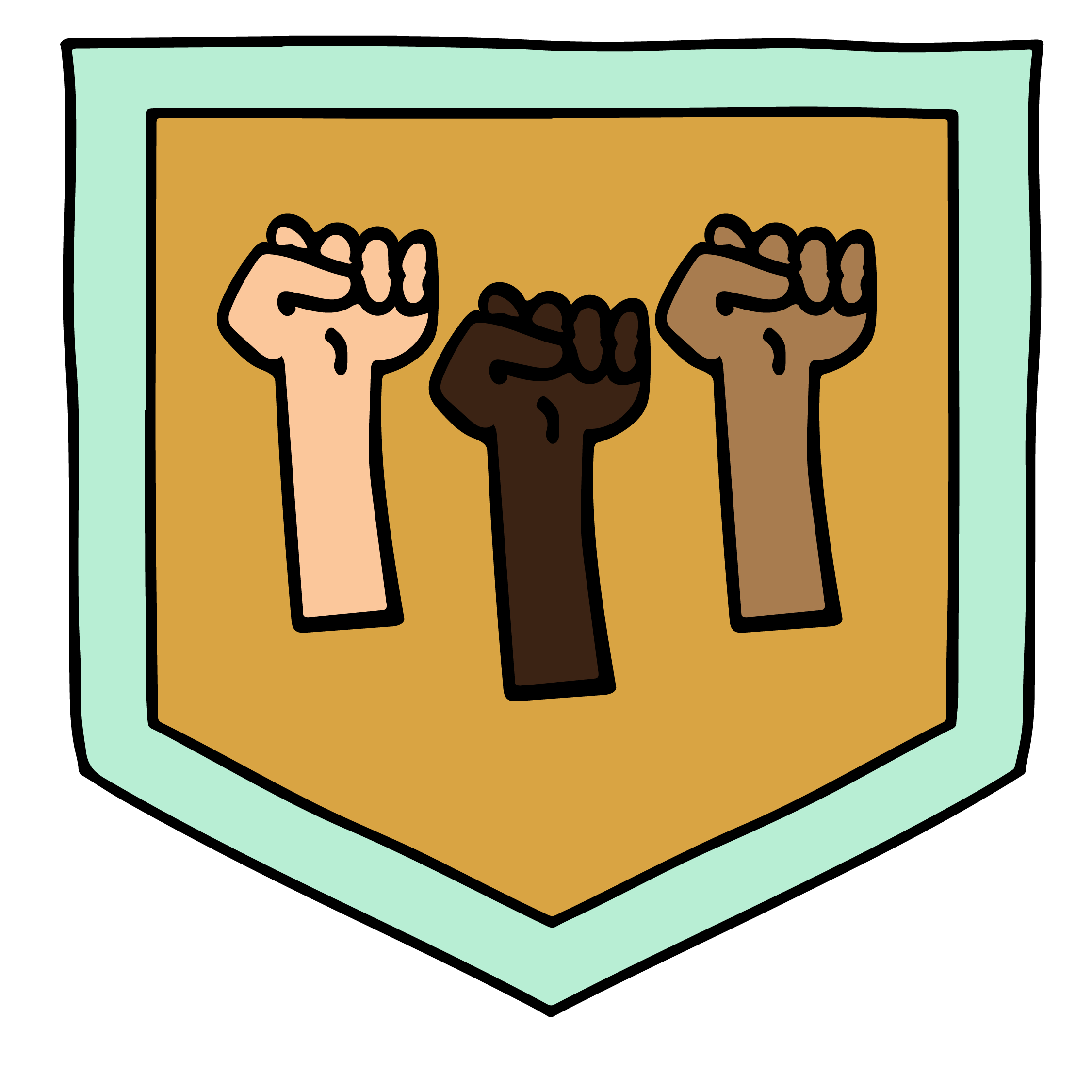
Action Box
Janis recommends several actions you can take "to counteract your own participation in Austin’s unique form of systemic racism," including - supporting Black-owned businesses and giving your money to nonprofits led by people of the Global Majority.
How are you doing these days? How are you experiencing this moment of unrest in our society? I am asking because we all have our strategies for surviving discomfort and conflict. And this is one of those times that we need to reflect and look ourselves squarely in the face. That’s why I am writing to you — the you that is reading this right now, especially if you are white and liberal here in Austin, Texas.
We environmentalists see ourselves as fighting the good fight through our causes, and we like to find reasons for inspiration. But I don’t want you walking away inspired after reading this. Please don’t feel better that someone like me is “finally saying what needs to be said.” Because: a) Yes, even this, has been said before, many times; and b) This moment is not about me, and it’s not about you, either. So if you walk away inspired, you didn’t get it.
The truth is, I want you walking away with a sick feeling in your stomach–the kind of pit-of-your-stomach feeling when you realize that you have been part of the problem, with a sense of growing dread over the impact your complacency has had, based in a knowledge that real changes are necessary from within your own skin, and that it will in no way be easy. I am not asking anything of you I am not willing to do myself. I live with that feeling.
In 2017 I wrote an article called Austin Is Charlottesville. It layed out the white liberal reaction to the racism exhibited at Charlottesville, and exposed it for what it was – a smokescreen. I called my own inauthentic urges to distance myself from “those racists,” and used myself as a (recovering) example of the worst kind of racist — a white “ally.” The kind of “progressive” white person who hopes to be seen as “woke,” the kind of white person who thinks it’s enough to stop at marching and having deep conversations about race. I used myself as an example because the liberal white reaction to racism is broken. And nowhere did I see this more prevalent than right here in Austin, Texas.
What you don’t know about that article is that in writing it, I formed some of the best relationships I have ever had with some of the most incredible Black and Brown leaders in this area. What you don’t know is that in writing it, I altered the trajectory of my life, and officially went down the rabbit hole of seeing racism for what it is, and seeing it absolutely everywhere. My career, my work, my life’s purpose, was forever altered. And I am deeply grateful. That’s the kind of moment I want to create for you right now.
Because this is a turning point. Now, as some Austin leaders bolster their strength and take bold action, while others lick their wounds, and still others pause to consider what stance they are prepared to take, I find myself peering into a moment of Austin’s identity crisis. The question is palpably present:
Who will we, as a community of communities, choose to become at this moment in time?
So let’s work on giving you that feeling in your stomach, OK? Let’s get down to what inequality looks like right here at home. By the way, this is not about feeling guilty. No one needs your guilt. We need your clarity and your action. We need you to ask yourself, “How do I personally benefit from and/or participate in the perpetuation of these realities and what am I willing to do about that?”
Policing In Austin is Broken
In general, Black and Latinx folks in Austin are not surprised by what has transpired with the treatment of protesters, and Mike Ramos’ death was sadly, not a new occurrence with APD. According to the most recent report on 2018 officer involved incidents:
“Officers’ apparent failure to use de-escalation tactics in many of the incidents, as well as their failure to use ‘less-lethal’ force options in all but one incident, is deeply troubling and requires further explanation by the department. Moreover, the 2018 data clearly reveals a disparate concentration of officer-involved shooting incidents affecting individuals who are ethnic minorities, as well as in areas of Austin that are historically minority-majority.”
While we *say* we have community policing, the truth is, the office dedicated to representing public complaints against the police has been met with resistance from APD. The Office of Police Oversight, our independant department dedicated to ensuring that the public voice is represented in matters of policing, is an incredible resource for the community, and the office dedicates time and energy to addressing community complaints against police.
Did you know that APD can pick and choose which complaints they investigate from the Office of Police Oversight? As a result, only a fraction of the complaints (roughly 25 percent) submitted to APD from this office are ever investigated. What’s more, the Tatum report showed that within APD, not only is racism and homophobia tolerated, but disciplinary records are likely intentionally disorganized and incomplete, and a fear of retaliation is fostered department-wide. Use of force training has never adequately included de-escalation, which was painfully apparent in the approach to Mike Ramos, who was shot at (with hands up) by a new cadet and then killed by an officer who had, within the year, killed someone else having a mental health episode.
Last week City Council unanimously passed items 50, 93, 94, 95 and 96, historic resolutions that begin the work of our much-need course-correction. I especially appreciated the brevity of the normally quite long “whereas” language on item 95, which simply states: “Whereas: Black Lives Matter.”
Most speakers spoke in favor of all of them. But one speaker that day implied that justice advocates should be grateful for being given a seat at the table and went on to argue against these items. But the situation is quite the opposite. Community members are rebuilding the table, and, in honor of Mike Ramos and all the fallen, they/we are committed to build it with the strength of real equity.
The question to ask yourself is, did you know any of this before two weeks ago? If not, I invite you to look at what issues you do pay attention to. Do you see any patterns?
White Privilege Is Killing Our Latino and Black Neighbors During COVID-19
As of June 9th, Austin’s COVID-19 outcomes by race were disproportionately severe for communities of color. The following chart visualizes data from the Travis County dashboard against population by race from the city website.
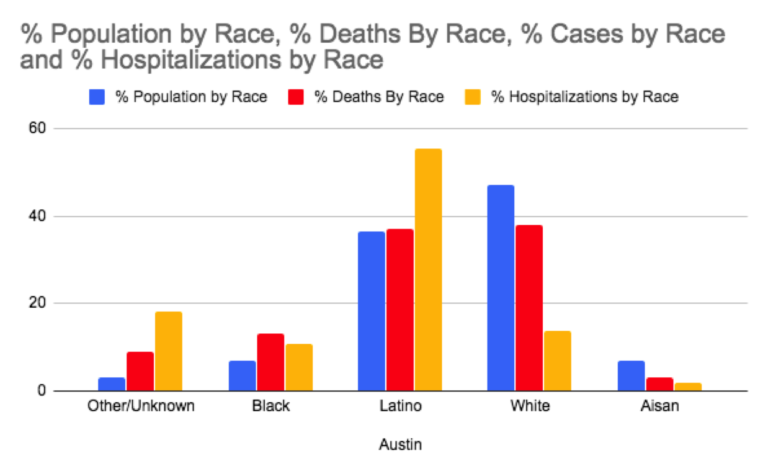
Several local media outlets reported this. People exploring this topic are questioning what to do about it. And by the way, in case there is any question about whether behavior explains the difference, think again. The reality is, communities of color have made more preventative behavioral changes, are more concerned about infecting other people, are more concerned about being hospitalized and know more people personally who have died from COVID-19. The focus should not be on changing opinion or behavior. They get it.
What is more likely to be the source of the issue is a combination of factors. For example, construction is one of the industries most common for COVID cases. In the US, construction is the most prevalent job for the Hispanic & Latino population. What’s more, people working on the front lines are more likely to have a higher viral load, especially if company practices do not protect them. Why does that matter? Because a higher viral load doesn’t just mean a higher chance of getting the virus, but also a higher likelihood of severe outcomes.
Another part of the story may be the well-documented lack of trust for the medical institution in general by Black and Latinx communities, due to a long history of discrimination and racism (continuing today), resulting in disproportionately bad outcomes for these communities.
But we don’t even get that far — because the vast majority of medical test sites (and medical facilities in general) are located in West (white) Austin, many people don’t have access to transportation, and even the location of COVID-19 testing sites has been disproportionately allocated. To illustrate, the map on the left shows, with black dots, the locations of testing sites against a heat map which clearly shows that all but one site is located in predominantly white neighborhoods. The map on the right, from the Ford Mobility study, shows that the location of medical specialists occurs mostly outside of the Eastern Crescent, where our communities of color now live, after having been displaced by gentrification.
Now, these disproportionate health outcomes are similar to just about every other city and country in the US (at least those who even report racially-linked COVID data). But it doesn’t have to be that way. Prior to the protests, the one county I found that does have racially proportionate outcomes was Broward County, Florida. And what are they doing differently? Well for starters, look at the next set of images.
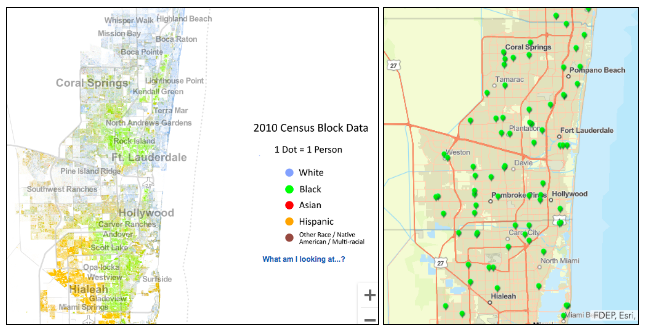
On the left is the population by race in Broward. On the right is the location of their testing sites. Do you see a difference?
The Racial Wealth Gap Is Alive And Real in Austin
Would it surprise you to know that the racial wealth gap is worse now than it was in 1963? Well, it’s true, and Austin is no exception. Here’s one excellent graph from Time Magazine, showing the growing disparity over time.
In another report, that featured research from Austin’s own historic Huston-Tillotson University, it becomes clear that Austin’s racial wealth gap is right on track with this damning trend. Spectrum news reported that: “While the area’s median income for white households is $72,341, it was only $40,004 for black households. Latino families are at $44,239.”
Our Public School System is Leaving People Behind
In the interest of keeping some form of schooling open, AISD pressed forward with a pass/incomplete model of education. This was an important alternative to grading during this pandemic, and represents the hard work of many local advocates. But how many students were unable to participate due in part to the digital divide, and will eventually be penalized by default? I haven’t seen any broad stats, but my son’s teacher said that roughly 25 percent of the students in his class had not been attending. Several Austin schools closed in silence and without ceremony, some of them having been a centralizing force on the East Side. Now, AISD is trying to hire a new superintendent, despite the fact that most parents are not in a position to have any kind of real input into what should be a community input process.
There Are LOTS of Businesses and Organizations Addressing These Issues. The Problem Is, We Are Not Supporting Them
There are actually plenty of solutions for these issues. Leaders of the Global Majority have built nonprofits and businesses that support Austin’s communities of color in ways that respond directly to the community’s needs. But they receive far less financial support from the broader Austin community. They receive fewer grants. They win fewer proposals. Their fundraisers are promoted less. Is that ok with you? Because you can certainly do something about that.
Nonprofits and local businesses are hurting, including musicians and artists. Like many very small businesses around the world, many local small businesses led by members of the Global Majority were excluded from participation in federal COVID relief funding programs at a rate of 95 percent due to arbitrary restrictions. Austin is no exception.
Now, below I am going to list some actions that you can take, right now, to support and amplify the work of these groups. But before I do, I want to close my thoughts by saying, what have you personally done about any of this? If your answer is protesting, ok, yes, that was certainly part of it, especially if you were conscious that your protesting listened to and amplified the voices of Black and Latinx organizers.
Protesting is important. But, then, have you given up your money? Have you given up a spot for someone else? Have you held the institutions you influence to account for ways in which they perpetuate systemic racism? Conversations about racism are important, but have you done any anti-racist training or educated yourself deeply on the heart of the matter? If you have not let yourself fully embrace the opportunity to transform your own involvement in racism, when will you ever? Now is this time. And as you do, please take care of yourself and experience joy along the way, but please do not sell out for inspiration. As my good friend Shane says about the work of undoing racism, if you are comfortable, you aren’t doing it.
Here are some of the actions you can take to counteract your own participation in Austin’s unique form of systemic racism.
Spend your money at businesses owned by the Global Majority. KXAN recently posted this list of Black-Owned Businesses.
Austin Black Business Journal started a GoFundMe campaign to support local Black owned businesses.
Lastly, and for me, this is so very important. Give your money to nonprofits led by the Global Majority. They have all the answers we need. Here’s a list.
African American Youth Harvest Foundation
Any Baby Can partners with thousands of families each year to build stability, develop skills, and unlock each child’s full potential.
Austin Area Urban League enables African Americans and other underserved urban residents to secure economic self-reliance, parity, power and civil rights.
Austin Justice Coalition educates and builds community power for people of color who live in Austin, Texas that need support, community, and liberation during a time of systemic injustice in America.
Austin Latino Music Association (ALMA) increases knowledge and awareness in the community about local musicians and important historical figures in Austin’s Latino music scene, providing exposure and resources to local musicians, and fostering the development of young musicians who will keep Latino musical styles and traditions alive in the Capitol City.
AVANCE aims to liberate parents and their children from the cycle of poverty in a family-oriented, non-judgmental environment.
Be The Bridge – Has a vision is that people and organizations are aware and responding to the racial brokenness and systemic injustice in our world.
Black Bodies Project is eradicating racism through creativity, connection, and collective understanding.
Black Mamas ATX helps black women survive and thrive before, during, and after childbirth.
Black Pflugerville is a nonpartisan non-profit organization which encourages informed and active participation of Black people in the city of Pflugerville.
Center for Mexican American Cultural Arts (CMACA) is dedicated to preserving, developing, and promoting the Mexican American/Latino heritage and culture and facilitating and encouraging a greater appreciation of Mexican American/Latino cultural arts by people of all backgrounds through education, research, and cultural programming.
Central Texas Allied Health Institute (CTAHI) works to expand and diversify the healthcare workforce through job training and placement for communities of color. They have a proposal in play to deliver mobile clinics to East Austin.
Change 1 provides Youth Services to Transition & Aged Out Youth 15- 26 years of age as they enter into adulthood.
Community Advocacy and Healing Project invites people to advocate through a healing lens by focusing additional attention to the human beings that are creating, administering, and/or impacted by systemically oppressive policy initiatives.
Communities of Color United advances racial justice, builds community and solidarity across communities of color, and supports collective self-determination.
Con Mi MADRE is a two-generation organization that empowers young Latinas and their mothers through education and support services that increase preparedness, participation, and success in post-secondary education.
DAWA is a safety net for people of color who are experiencing a short term life crisis.
DJ Bling Foundation is a non profit organization that provides free school supplies and educational resources to students of low-income families in Texas.
Excellence and Advancement Foundation – dedicated to transforming how communities combat the school to prison pipeline.
Grassroots Leadership works for a more just society where prison profiteering, mass incarceration, deportation, and criminalization are things of the past.
Go Austin Vamos Austin is a coalition of neighbors and community partners breaking down barriers to healthy living and strengthening neighborhood stability in Austin’s Eastern Crescent
Hearts 2 Heal is a community based nonprofit, working to educate peer support leaders, and provide culturally appropriate mental health and wellness.
Huston-Tillotson University – Austin’s oldest higher education institution and a proud HBCU. HT nurtures a legacy of leadership and excellence in education, connecting knowledge, power, passion, and values.
Kardia Advisory Group envisions a world where every organization has talented, socially conscious and innovative teams that honor diversity, equity and inclusion.
LULAC advances the economic condition, educational attainment, political influence, housing, health and civil rights of Hispanic Americans through community-based programs.
MEASURE uses data and education to mobilize communities to eliminate social disparities.
Mexic-Arte Museum is dedicated to cultural enrichment and education through the collection, preservation and presentation of traditional and contemporary Mexican, Latino, and Latin American art and culture to promote dialogue and develop understanding for visitors of all ages.
NAACP is working to secure the political, educational, social, and economic equality of rights in order to eliminate race-based discrimination and ensure the health and well-being of all persons.
PODER (People Organized in Defense of the Planet and Her Resources) is redefining environmental issues as social and economic justice issues, and collectively setting their own agenda to address these concerns as basic human rights.
Rosa Rebellion a platform for creative activism by and for women of color.
Six Square Preserving and Celebrating the historic legacy of the African American community that once thrived in Central East Austin.
Survive2Thrive Foundation – Run by people of color and former victims of domestic violence.
Texas Appleseed is promoting social and economic justice for all Texans by leveraging the skills and resources of volunteer lawyers and other professionals to identify practical solutions to difficult systemic problems.



